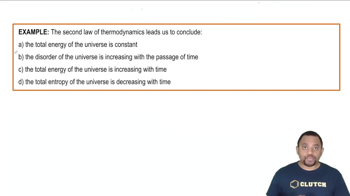Indicate whether each statement is true or false. (a) Unlike enthalpy, where we can only ever know changes in H, we can know absolute values of S. (b) If you heat a gas such as CO2, you will increase its degrees of translational, rotational and vibrational motions. (c) CO2(g) and Ar(g) have nearly the same molar mass. At a given temperature, they will have the same number of microstates.
Ch.19 - Chemical Thermodynamics
Chapter 19, Problem 41a
Predict the sign of the entropy change of the system for each of the following reactions: (a) N2(g) + 3 H2(g) → 2 NH3(g)
 Verified step by step guidance
Verified step by step guidance1
Identify the states of matter for the reactants and products. In this reaction, all species are gases.
Count the number of moles of gaseous reactants and products. For the reactants, there are 1 mole of N_2 and 3 moles of H_2, totaling 4 moles. For the products, there are 2 moles of NH_3.
Compare the total number of moles of gas on the reactant side to the product side. The reactant side has 4 moles of gas, while the product side has 2 moles of gas.
Recall that entropy (S) is a measure of disorder or randomness. A decrease in the number of moles of gas typically indicates a decrease in entropy, as gases have higher entropy than liquids or solids due to their greater freedom of movement.
Predict the sign of the entropy change (ΔS) for the system. Since the number of moles of gas decreases from reactants to products, the entropy change is likely negative (ΔS < 0).

Verified Solution
Video duration:
59sWas this helpful?
Key Concepts
Here are the essential concepts you must grasp in order to answer the question correctly.
Entropy (S)
Entropy is a measure of the disorder or randomness in a system. In thermodynamics, it quantifies the number of ways a system can be arranged, with higher entropy indicating greater disorder. Understanding entropy is crucial for predicting the spontaneity of reactions and the direction of energy flow.
Recommended video:
Guided course

Entropy in Thermodynamics
Gaseous Reactions and Molar Volume
In reactions involving gases, the number of moles of gas can significantly affect entropy. When the number of gas molecules decreases, as in the reaction N2(g) + 3 H2(g) → 2 NH3(g), the system becomes more ordered, typically resulting in a negative change in entropy. This concept is essential for analyzing the entropy change in gaseous reactions.
Recommended video:
Guided course

Standard Molar Volume
Second Law of Thermodynamics
The Second Law of Thermodynamics states that the total entropy of an isolated system can never decrease over time. It implies that spontaneous processes increase the overall entropy of the universe. This principle helps in predicting whether a reaction will occur spontaneously based on the sign of the entropy change associated with the reaction.
Recommended video:
Guided course

Second Law of Thermodynamics Example
Related Practice
Textbook Question
408
views
Open Question
For each of the following pairs, predict which substance has the higher entropy per mole at a given temperature: (a) Ar(l) or Ar(g) (b) He(g) at 3 atm pressure or He(g) at 1.5 atm pressure (c) 1 mol of Ne(g) in 15.0 L or 1 mol of Ne(g) in 1.50 L (d) CO2(g) or CO2(s)
Textbook Question
For each of the following pairs, predict which substance possesses the larger entropy per mole: (a) 1 mol of O2(g) at 300 °C, 0.01 atm, or 1 mol of O3(g) at 300 °C, 0.01 atm
953
views
Textbook Question
Predict the sign of the entropy change of the system for each of the following reactions: (b) CaCO3(s) → CaO(s) + CO2(g)
504
views
Textbook Question
Predict the sign of the entropy change of the system for each of the following reactions: (c) 3 C2H2(g) → C6H6(g)
927
views
Textbook Question
Predict the sign of the entropy change of the system for each of the following reactions: (d) Al2O3(s) + 3 H2(g) → 2 Al(s) + 3 H2O(g)
1504
views
